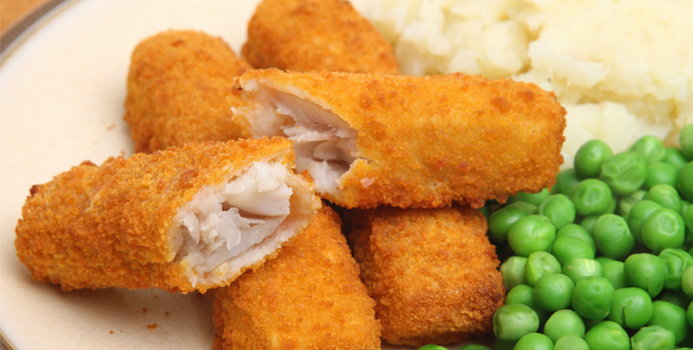Pros and cons exist for choosing frozen fish sticks as a snack. Fish and seafood do contain a variety of essential nutrients. However, many types of fish sticks are breaded, fried, and high in calories and sodium. If you often reach for frozen fish sticks as a snack, make sure to do so in moderation.
Beneficial Nutrients in Fish
Fish sticks are generally made using Pollock, haddock or cod -- all white fish rich in protein, vitamin B-12, and niacin.Frozen fish sticks generally contain about 3 grams of protein per stick, according to the U.S. Department of Agriculture (USDA) National Nutrient Database. Therefore, if you eat a serving of five fish sticks you're getting about 15 grams of dietary protein. Protein aids in healthy weight management, increases satiety, and helps build and repair muscle tissue.
Calorie Concerns
Because fish sticks are generally breaded and fried, most are not low-calorie foods. One frozen fish stick contains 78 calories, according to the USDA. So, if you're eating a portion of five sticks as a snack, you may be ingesting about 390 calories. In comparison, a 3-ounce portion of cooked Atlantic cod contains just 89 calories and almost 20 grams of protein. If you do opt for fish sticks instead, look for reduced-fat baked fish sticks, containing about 180 calories and 9 grams of protein in each portion of five sticks.
Sodium Considerations
Fish sticks are generally high in sodium, which can be problematic if you have high blood pressure or heart disease. According to the USDA, a serving of five frozen fish sticks contains 565 milligrams of sodium. Even five reduced-fat baked fish sticks contain 340 milligrams of sodium. The Dietary Guidelines for Americans 2010 suggest limiting dietary sodium intake to 1,500 to 2,300 milligrams daily, and the American Heart Association recommends consuming less than 1,500 milligrams of sodium per day.
Bottom Line
Baked fish is healthier than frozen fish sticks because it contains more protein, vitamins and minerals, but fewer calories and less sodium. If you do choose fish sticks instead, do so in moderation, be mindful of your overall calorie intake and limit dietary sodium to recommended levels. Doing so means you can still include small portions of fish sticks in a heart-healthy meal plan.
Food Myths: Added Sugar Is Always Bad for You
An experienced health, nutrition and fitness writer, Erin Coleman is a registered and licensed dietitian and holds a dietetics degree from the University of Wisconsin-Madison. She also has worked as a clinical dietitian and health educator in outpatient settings. Erin's work is published on popular health websites, such as TheNest.com and JillianMichaels.com.




